
An Instagram screenshot of the Sliver couloir from @ryan_burke11.
On Saturday, January 22, two skiers ascending the Sliver Couloir on Nez Perce in Grand Teton National Park were caught in sluff caused by a descending snowboarder. One skier, Michael Martin (24) of Jackson, Wyoming, fell and slid down the Sliver and over a rock band. His partner, Collin Binko (30), also of Jackson, was frayed but uninjured. Martin suffered non-life-threatening injuries but was evacuated by helicopter several hours later.
High pressure has reigned for a few weeks in much of the West. Snow conditions, generally speaking, have been stable. And with that stability, more ski lines are open for consideration: that includes the Sliver Couloir.
The accident details are unnerving and raise questions about communication, backcountry ethics, and safe travel in exposed terrain. I first learned of the incident from Jed Porter’s Instagram – Porter is a Driggs-based IFMGA guide. Porter posed some questions he has raised previously on WildSnow. His piece, “You Have to Climb What You Ski,” Or do You? was published in May 2021 – not so long ago.
The top-down, bottom-up debate was only the beginning.
A Teton-based skier and mental health counselor, Ryan Burke arrived on the accident scene approximately two hours after Martin’s fall. He had this to say about the Sliver.
“The Sliver Couloir is something that is mostly done from down-up,” said Burke on Monday morning when asked about accessing the line. “It’s kind of hard to think of it as a top-down route because you’d have to come up the East Hourglass, which has two big rock bulges on it. I’ve never heard of anyone doing the Sliver top down.”

Map screenshot from backcountryrecon.com.
For background, the East Hourglass is a more technical ski line on Nez Perce and is opposite the Sliver once you top out. The Sliver, however, splits down the East face of Nez Perce and runs roughly 1000 feet, and in low snow conditions, which the skiers experienced, a cliff band protects the runout.
The events in the Sliver are evidence of couloir congestion and the need for solid inter-group communication and discussions about dropping in on a group after you have passed them.
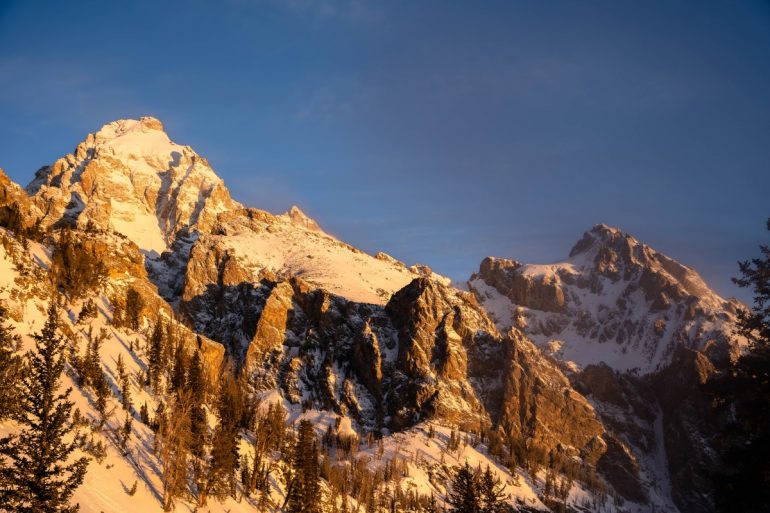
Sunrise on the Grand and Teewinot as Martin and Binko approach the Sliver. Photo: Michael Martin.
Saturday in the Sliver
Martin and Binko
Martin explains the day’s plan: ascend and ski the Sliver, then reascend the Sliver a second time and rap into and ski the East Hourglass. They’d stash any unneeded gear on the initial Sliver ascent in a safe spot near the couloir’s entrance.
Approx: 9:30 AM: The two decide to dig a pit and execute an ECT test to determine snow stability. “From the snow pit, we noted 6-8 inches of new snow from the storm two days prior on top of a crust layer,” wrote Martin. “We felt good about what we were seeing. The main concern at that point was the snow surface warming quickly as the line was in full sunlight.”
Binko says the pits results were, “ECTN 26 @ 30cm approx. down.”
Approx: 10:00 AM: As the two conclude their pit assay and are ready to ascend, the solo snowboarder passes by, 30 to 40 feet away, Binko estimates. There’s no verbal exchange between the groups. “There was no acknowledgment from him; he did nothing,” said Binko.
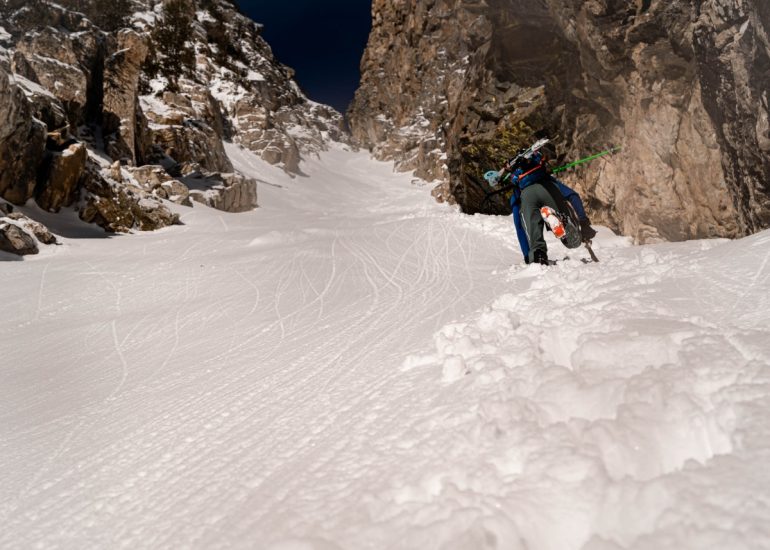
Collin Binko booting up the Sliver Couloir in Grand Teton National Park on Saturday. Photo: Michael Martin.
The snowboarder continues booting, with Martin and Binko roughly five minutes behind in his wake. Martin, Binko, and the snowboarder move at similar speeds. But the last third of the couloir, Binko notices the person out front up their pace.
“But he kept looking back at us, like gauging where we were,” said Binko. I was just like, okay, cool. He has eyes on us. We have eyes on him. Everything should be fine. I had in my mind that he is out here crushing it solo; he probably knows what’s up and just assuming that we would pull up to the top and he’d be there, already transitioned, ready to rip.”
Due to the nature of the upper couloir, where it doglegs, neither Binko nor Martin sees the snowboarder transition. Binko was 30 to 40 feet ahead of Martin, roughly 70% up the couloir. The chatter between the two assumed that the snowboarder knew they were ascending from below.
Martin recalls telling Binko, just before the snowboarder’s drop, that they were positioned in perhaps the most exposed section of the couloir. Moments later, the snowboarder, already in the fall line, came to a complete stop in what Martin describes as “a safe spot just up to the lookers right side of the slope.”
Any elusive sense of safety evaporated as Binko recalls the next time he sees the snowboarder, he’s making the cross-couloir cut.
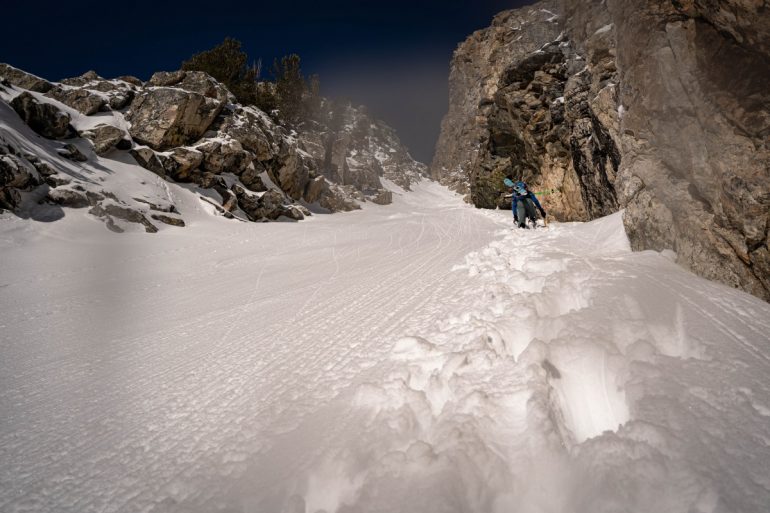
The sluff hit the skiers at approximately 10:40 AM. Photo: Michael Martin.
Approx. 10:40 AM: The sluff begins cascading. Neither Martin nor Binko were in a spot to avoid the flowing snow. Higher up, closer to the initial snow flow, Binko kicks his feet in and assumes a self-arrest position. “I had just kicked in to pause before the snowboarder made his cut,” said Binko. “I had a good stance to begin with and then kicked in again when the sluff came. And then it came over me. It was roaring, pretty full-blown.”
Binko sees his partner hanging on momentarily, resisting the slide. He’s trying to kick in. “The slide passes me, and I look over at Mike, he hangs on, but the ground disappears below him. Then I see him get flipped backward.”
He says Martin struggled to get on his stomach. But at one point, his skis, secure in an A-frame, dig into the slope and decelerate him, ripping the side of his pack out. Then Martin disappears in a mass of moving snow out of sight around a corner.
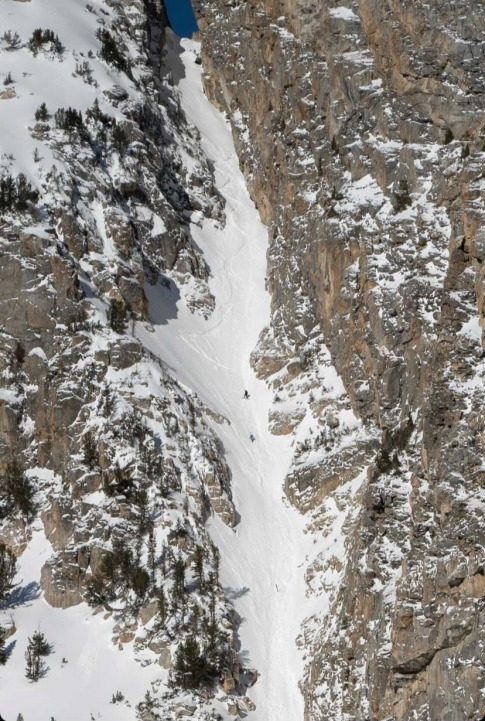
This image of the Sliver Couloir shows the snowboarder stopped above Collin Binko after the slide. Photo: Chase Rumholz.
“I saw the sluff wash over Collin, and as it approached me, I dug my ice axe and crampons as deep as I could and tried to brace against the slope,” relayed Martin. “What was under my feet gave out, and that’s what started the ride. In my attempt to self-arrest, I caught my crampon’s front points and got flipped out of the snow.”
Fighting to remain on top of the sliding surface, Martin attempts to self-arrest in spots and protect his face and head when the axe could not find purchase. “I was trying to stop before the exit cliff but was disoriented enough that I had no clue where I was. My helmet got pretty banged up on the ride down, and I was a couple of inches underneath the snow surface when it started to slow down on the apron. I fought to get to the top and rose to snow surface right when it came to a stop.”

A clean shot of the Sliver. Photo: Michael Martin.
Post-Slide
Binko clings to a firm bed surface. He chooses not to transition into skis and downclimbs.
“I just started downclimbing as fast as I could and looked up at the snowboarder who was just standing there at the end of his cut,” said Binko. “I yelled, ‘do you have eyes on him? Do you have eyes on him?’ And he just stood there.”
According to Binko, the snowboarder snapped to and replied, “no.”
Martin says two minutes after the slide, the snowboarder was first on the scene. Blinko arrives a few minutes later and performs an initial assessment ruling out head-neck-spine injuries. There were, however, abrasions on Martin’s elbows and forearms and reduced mobility in his right ankle, knee, and hip. Post-assessment, Binko, and Martin traverse the apron to access dry clothes and their extra gear.
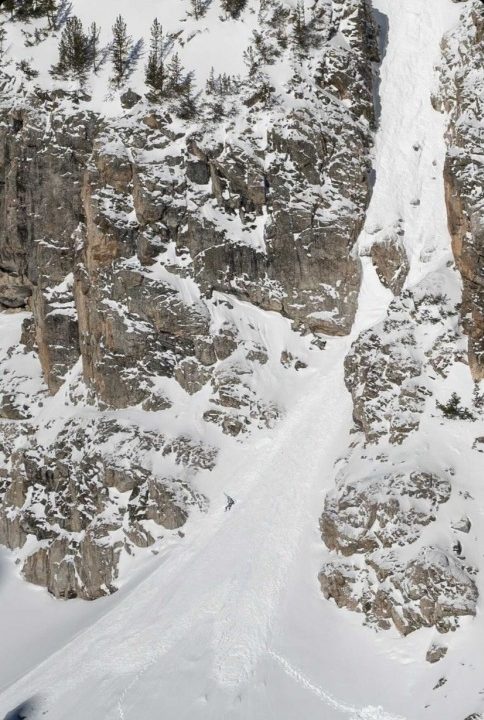
A photo taken after the slide on the Sliver Couloir shows the debris field. Photo: Chase Rumholz.
Four other skiers in a different group witnessed Martin’s slide -one member began melting snow for water, offering a puffy and dry socks. They bandage any wounds and continue to assess any potential injuries. (Both Martin and Binko are Wilderness First Responder (WFR) certified.
11:18 AM: An inReach is activated. According to Martin, this is when he believes the snowboarder that triggered the slide departs.
Search and Rescue communicates with an individual from the group of four skiers on a cell phone; they found a location with adequate cell service. Burke and his partner arrive as the four skiers who happened upon the scene begin to leave. The Burke party supports Martin as he hobbles to a suitable flat spot below the apron where a helicopter can land.
1:30 PM: After an initial pass, the heli picks Martin up and flies him to Windy Pass. Burke’s party skis out of the canyon with Binko.
Martin says the hospital visit reveals a chip fracture along with a sprain in his right ankle and a strained LCL in his knee.
“Looking back on the incident with Collin, we both feel like we were making good decisions and in the right mindset for the day,” explained Martin. “We had both felt really good, were moving great, and were having a really good open dialog through the day. We both agree that the only thing we would have changed would be saying something to the solo snowboarder when we were finishing up our snow assessment.”

Part of Burke’s Instagram story. Screenshot @ryan_burke11.
From Burke’s Eyes
Earlier in the morning, while the two skiers and snowboarder were ascending the Sliver, Burke and a partner were across the valley, atop Shadow Peak. They intend to climb the Sliver too, top out, and then ski the East Hourglass, that technical ski line involving a rap-in accessed atop the Sliver.
On his approach to the Sliver, Burke snaps a photograph, which he later includes in his own Instagram story about the incident. “I took that as we were going to go to do the same run as the two skiers, we’re going to the East Hourglass, which means you repel down the backside of this Sliver,” said Ryan. “So I took that photo on our way across, not knowing what happened yet.”
Near the entrance to the Sliver, Burke’s party encounters the ski party of four.
“The quick synopsis is we have to kind of ski down to an indentation to get up to the Sliver,” said Burke. “We met a party of four there; they filled us in on the situation a little bit. They were the ones that had called for a rescue. They had already made sure that the two skiers that were involved in the actual slide were okay, and then they descended as a group because they were getting cold, I believe.”
Burke’s group ascends to the two skiers involved with the slide and wait for the rescue chopper.
“We then were able to go up to the two skiers and hear more and realized that it had been a kind of a solo snowboarder that had descended above them, as they were approaching up and created kind of a slough kind of avalanche which took the second skier off of his feet. The first skier was closer [to the snowboarder] and just didn’t have as much power in his slide. Keep in mind, as one commenter to Porter’s post noted, the Sliver traditionally is a bottom-up line.
“Jed’s post was a great starting discussion point for this particular incident,” said Burke. “But, top-down isn’t quite as much of a possibility. It’s one of the couloirs that gets so done. And I talked to Adam Wirth in the parking lot, and he said one day he saw 27 people ski the Sliver Couloir in one day, and, you know, it’s wild numbers. [The Sliver] is so close to that moderate kind of run. On most days, however, you do see two or three groups in it.”

Colin Blinko skiinng up the apron of the Sliver Couloir. Photo: Michael Martin.
Reflection
This much is clear, the ski theater in which some operate has a limited carrying capacity for ascenders and descenders. And the margins, once at capacity, are razor-thin.
In communication later on Monday, Porter added a salient point regarding general awareness and norms in some ranges mountains.
“The Sliver, it’s true, can’t be done ‘top down,'” wrote Porter. “That makes consideration of who’s above even more important. Fact is, though, very few ski lines in the Tetons are like the Sliver. Most can be done top down, but that message isn’t getting out there very well. I skied a serious line yesterday, accessed with easy, safe skinning, that had a boot track in it. The Sliver will always have this issue and traffic will be limited accordingly. Management of the hazard will always require case-by-case communications in these few bottom-up-only lines. In these busier and busier times, ski defensively.”
Wise words, “ski defensively.”
“Mike and I have both talked about the same thing,” said Binko. And the answer to what went wrong begins with not making contact with the snowboarder. “I could have said, at some point, when he passed us around the start of the booter or, near the top, like, ‘Hey, you’re gonna wait for us?’ Or, ‘hey, can you wait till we are in a safe zone before you descend?”
Binko went on to say this: “The biggest takeaway is not to assume, just because someone’s in a certain place or going after a certain line, that they have the foresight to know what their actions could cause. We spend so much time looking at the snowpack and looking at X, Y, and Z. I just botched the human factor. I should have yelled up at that dude. I’m better than that. I should have known that, okay, this guy passed this on the booter. How do I mitigate that risk?”
Postscript notes: Both Binko and Martin brought emergency gear to sit through a rough night in the event of difficulties in the East Hourglass. They each carried a belay jacket, extra food and water, a bivy bag, and a space blanket.
Jason Albert comes to WildSnow from Bend, Oregon. After growing up on the East Coast, he migrated from Montana to Colorado and settled in Oregon. Simple pleasures are quiet and long days touring. His gray hair might stem from his first Grand Traverse in 2000 when rented leather boots and 210cm skis were not the speed weapons he had hoped for. Jason survived the transition from free-heel kool-aid drinker to faster and lighter (think AT), and safer, are better.
